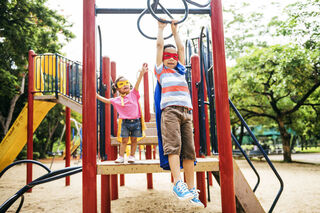Play
This Play Tweak Can Supercharge Your Child's Development
Four hidden ways that playground play fosters psychological development.
Posted May 26, 2020
One of the problematic side effects of the corona crisis has been the restriction of playground play. Closing parks and restricting use of public playsets makes sense from an infection control perspective but can impede child development in many hidden ways.
That’s why I’m celebrating the trend towards people installing play-sets in their homes. Parents are realizing there’s an intense need for this form of play, and are rising to that challenge. If necessity is the mother of invention, the corona crisis is the mother of intense creativity. Although I’m not a handy person, I’ve been following DIY videos of how people are creating “home” playgrounds, obstacle courses, and swing structures. I’ve seen the most creative designs and brilliantly repurposed materials. I’ve seen tiny apartments being transformed into active play areas.
Whether you’re a DIY and handy sort, or like me, wouldn’t trust a child on something you’ve constructed, here are some factors to consider when designing a gross motor play structure.
Personally, since I’m not handy, I ordered an outdoor play-set for my children, because I realized they’re missing out on the essential gross-motor, fine-motor, self-regulation, and imaginary play that playground structures offer them. While some locations are reopening parks and playgrounds to some limited degree, we are still far from full reopening. Opening a public park and playground but not reopening the bathroom facilities does not work for families with young kids! (Anyone who doesn’t understand why has never tried to potty train a young human.)
The parents who are providing this form of play for their children are really teaching some hidden skills. Of course, there’s the obvious. Play structures provide children the opportunity to practice gross motor skills. They provide exercise, and the ability to blow off some steam. But there are some hidden benefits to playground play that parents may not even realize they are fostering.
I: Teaching Grit
Grit is a construct that includes two components: effort and self-control. Children who have enough self-control and willpower to keep persevering despite frustration, and children who are willing to expend effort and tolerate discomfort in order to learn, have grit. We can also think of grit as passion + perseverance.

Play structures like monkey bars, climbing walls, or the fireman’s pole are excellent ways to foster grit. For many children, the first time they realize that the playing field isn’t even and can’t be artificially made even, is literally on the playing field! Before competitive sports, there’s the playground. Some children can climb up ladders, race across a monkey bar, or slide down a pole easily. Other children have to work on it. Maybe they’re overcoming fear. Maybe it’s their grip strength or core stability that needs work. (For more on helping kids overcome fears, click here, here, and here.)
For the first time, children are confronted with a challenge that requires perseverance, frustration tolerance, and a significant learning curve. The passion is there simply because they want to join their friends. It’s fun. Angela Duckworth speaks of encouraging grit through “calibrated meanness.” On the playground, it’s the equipment that provides it.
II: Flow State
Remember when you first tried to learn to pump a swing? At first, you relied on being pushed by a parent. Eventually, someone coached you through pumping your legs forward while leaning back. Suddenly, you had it! It’s like your arms, back, and legs suddenly magically figured out the exact proportion of movement they needed to pump that swing and keep it going.
That kind of magical “coming together” and figuring out how to do something is likely the first time you experienced a flow state. You feel energized, alert, and focused. You’re fully involved in the activity, and it feels magical. To use another analogy, it’s like you’ve dialed into the Matrix. When I want to help people understand what a flow state feels like, and how getting into one can help the creative process, I ask them to recall being on a swing as a child.
I’ve used that feeling of getting the hang of swinging to coach kids through other experiences that seem to be effortless for others but aren’t working out for them. Just like when you swing, it suddenly goes from extremely effortful to effortless, and that feels magical, other skills are like that as well. Socializing in a group might feel effortful and overlearned. It might feel like you’ll never get the hang of it. But if you keep on trying and practicing, you’ll suddenly be doing it, and that will feel magical. (For more on social anxiety, click here and here.)
III: Sensorimotor Control
Playground play helps with so many of our sensorimotor systems. When we talk about emotion regulation in children, we sometimes forget that these systems rely on much smaller building blocks — our vestibular system, our proprioception, and our interoception. These systems work together to give our bodies a sense of balance, a sense of where we are in the world, and allow us to experience internalized feedback from our bodies.
The vestibular system and proprioceptive systems work together to help us balance, control eye movements, and understand our spatial orientation. They allow us to know where our bodies are in space, without visual feedback. They allow us to navigate the physical world. Usually, these systems develop seamlessly, and we generally only perceive them in their absence.
Outdoor and playground play stimulate these systems. Swinging in a hammock, a standard swing, or a glider gives these systems a workout. Sliding down a sliding pond allows a child to integrate his vestibular system with his core. To slide, you have to balance your weight ever so slightly, tightening your core muscles and leaning backward. This helps train your vestibular system and proprioception and can help your brain train itself to make all sorts of minute adjustments to aid in balance. Knowing where you are in space doesn’t only help with sports. Kids with better proprioception know how to fidget in a way that increases their focus and concentration.
Proprioception is also one of the foundations of emotional intelligence. If your child comes home from school with a tense posture, downturned lips, vibrating with suppressed emotion, and with arms folded, you might ask “What’s wrong?” When the child says “Nothing. I’m fine,” what happens next? Do you believe her? Or do you continue to probe? You trust your proprioceptive sense of what that person’s body is telling you much more than you do their words. A child’s proprioceptive sense helps them learn nonverbal communication. Outdoor and playground play is one way to increase that capacity.
These systems also work hand in hand with the interoceptive system, the part of your brain that can sense internalized feedback. Interoception is how you know when you’re tired, hungry, thirsty, need the bathroom, or starting to feel stress. That’s a major building block of self-regulation. We can start increasing a child’s interoception by making her aware of how she feels on the playground- what does it feel like to swing? To rush down the slide? How does it feel in her ears, on her face, in her stomach? Because it’s so much fun, kids are willing to describe and tune in to the sensation.
IV: Cause and Effect
Cause and effect reasoning is a foundational component of executive functioning. it’s what allows kids to engage in task analysis, task planning, and time management. Playground play is one of the ways kids can integrate cause and effect reasoning. If I pump on the swing with my legs far apart, will that be easier or harder? If I try to go down the slide on my belly, what happens? Do I slide faster when I lean back or forward? If I switch my grip, does that let me traverse the monkey bars more efficiently? This type of thinking is the origin of experimental analysis. As Albert Einstein said, play is the highest form of research. I’d add that without play, we don’t develop our capacity for research.
When I look at a playground, I don’t just see brightly colored structures. I see adventure and imagination. I see frontal lobe competencies developing. I see kids learn to enter a flow state. I see grit, determination, and perseverance. I see vestibular, proprioception, and interoception training. Most of all, I see kids having fun while developing all of these skills. That’s the true utility of a playground. As a child psychologist, my recommendation is: Don’t play around with play.
© Robyn Koslowitz, 2020
References
Duckworth, A. (2016). Grit: The power of passion and perseverance. Scribner/Simon & Schuster.




